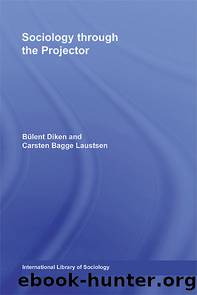Sociology Through the Projector by Bulent Diken Carsten Bagge Laustsen

Author:Bulent Diken, Carsten Bagge Laustsen [Bulent Diken, Carsten Bagge Laustsen]
Language: eng
Format: epub
ISBN: 9780415445986
Barnesnoble:
Publisher: Taylor & Francis
Published: 2008-03-19T00:00:00+00:00
In another sense, too, the relationship between sublimation and seeing/being seen (e.g. through the camera) is decisive in City of God. The stakes of struggle for symbolic power are images that âconstructâ social reality (Bourdieu 1990:134). However, symbolic capital âonly exists in the eyes of the othersâ (Joppke in Ãaglar 1995:311). In this context, the photographic image is a percipi, a being-seen-ness, and functions as positive or negative symbolic capital (Bourdieu 1994:191). For the favela occupies a dominated position in the field of power, it is categorized (the etymological root of the word, kategorein, means âto accuse publiclyâ; Bourdieu 1990:34). The people in City of God have an uncompromising deficit in symbolic power, which is accentuated by the fact that the struggle for symbolic capital goes through distinctively local paths within the favela. No wonder, then, that we learn about City of God only through Rocket, the escapee.
Pauolo Lins, the writer of the novel Cidade de Deus (1997), was a former favela resident and a research assistant to Alba Zaluar, a leading anthropologist who specialized in favelas, violence and drug trade. This role as researcher/insider produced a powerful reality effect, which was further intensified by the film in 2002. Thus, many commentators welcomed City of God, finding it ârealisticâ because it is âplayed by real slum kidsâ (Mourao 2003). After all, âa true story can be as brutal as Pulp Fictionâ (Karten 2003). As Jaguaribe (2003:1) points out in a broader context, in Brazil the 1990s saw the âreturn of the realâ through a series of realist representations of the favela that effectively sought to produce a âshock of the realâ, signalling the impossibility of representing Brazil as one nation. Or in Baudrillardâs words, âthe characteristic hysteria of our times: that of the production and reproduction of the realâ (Baudrillard 1994:23).
It is naive, however, to suggest that the film merely re-presents a profound reality. To confer upon City of God a realism is merely to confirm one perspective â in this case the Orientalizing middle-class perspective of the successful black escapee â in the tautological conviction that an image of the favela âwhich is true to its representation of objectivity is really objectiveâ (Bourdieu 1990:77). Fictionalizing the favela necessarily pushes away or masks some realities (e.g. contact zones, flows, etc.). However, what if the representations of the favela not only mask a reality but also an absence?
Indeed, the secret of City of God can only be understood when focus is shifted from the dissimulation of something (e.g. through âfictionalizing the favelaâ) to the dissimulation of an absence. As Baudrillard has shown, there are four discourses on the relationship between image and reality: an image can reflect a reality, it can mask a reality or it can disguise its absence and, finally, by itself becoming a simulacrum, an image can cease to bear any relation to a reality (Baudrillard 1994:6). Presenting the favela as a state of nature, City of God projects the âproblem of despotismâ to this fantasy space, creating
Download
This site does not store any files on its server. We only index and link to content provided by other sites. Please contact the content providers to delete copyright contents if any and email us, we'll remove relevant links or contents immediately.
Still Foolin’ ’Em by Billy Crystal(36210)
Spell It Out by David Crystal(35998)
The Great Music City by Andrea Baker(31093)
Professional Troublemaker by Luvvie Ajayi Jones(29547)
Trainspotting by Irvine Welsh(21461)
Call Me by Your Name by André Aciman(20328)
We're Going to Need More Wine by Gabrielle Union(18911)
The Secret History by Donna Tartt(18767)
Cat's cradle by Kurt Vonnegut(15112)
Ready Player One by Cline Ernest(14452)
Molly's Game by Molly Bloom(14030)
Bombshells: Glamour Girls of a Lifetime by Sullivan Steve(13933)
The Goal (Off-Campus #4) by Elle Kennedy(13377)
Leonardo da Vinci by Walter Isaacson(13114)
4 3 2 1: A Novel by Paul Auster(12233)
The Social Justice Warrior Handbook by Lisa De Pasquale(12087)
The Break by Marian Keyes(9272)
Crazy Rich Asians by Kevin Kwan(9133)
Adultolescence by Gabbie Hanna(8789)
